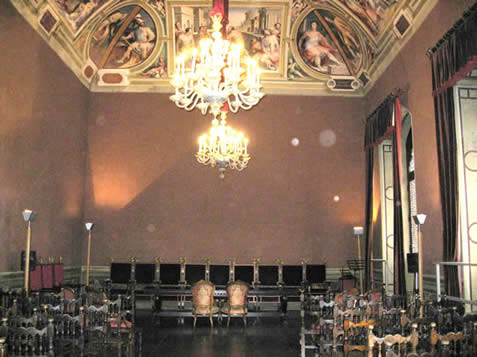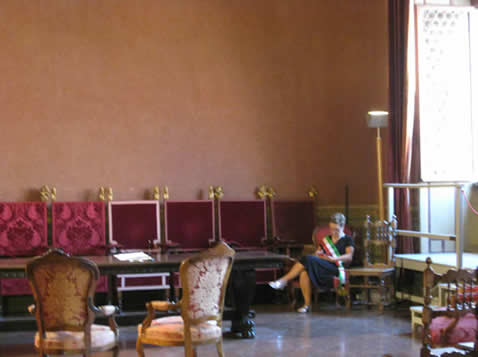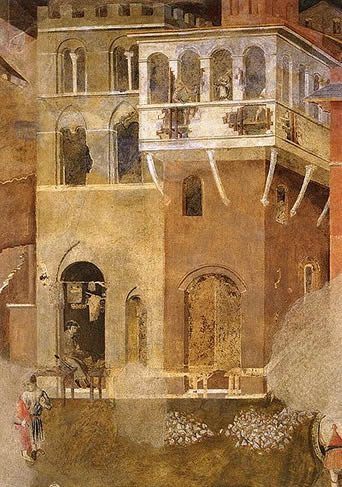INDEX
1. SIENA - MUSEUMS AND PALAZZI
- Palazzo Pubblico
2. SIENA - CHURCHES
3. PLACES WITHIN HALF AN HOUR OF BARONTOLI
6. SIENESE PAINTERS
7. SAINTS IN ART
PALAZZO PUBLICO – SIENA TOWN HALL
Dominating the Campo (Siena’s main square), it is one of the great secular buildings of Italy, with Simone Martini’s masterpiece, the Maiestà, and the iconic fresco of the horseman Guidoriccio da Fogliano riding through the Sienese landscape. A must.
The building still functions as the town hall, and only part of the first floor, the Museo Civico, is open to the public. Entrance from the courtyard to the right of the little loggia at the bottom of the tower. Open evey day 10.00-19.00 (summer) and 10.00-17.30 (winter). Separate ticket to go up the tower (Torre Mangia).
A huge, austere but graceful Gothic structure with magnificent crenellations and a tower that can be seen for miles around, built in the early 14th century when Siena was riding at her highest, just before the disaster of the Black Death that carried off half her population. The stone loggia below the tower, the Cappella di Piazza, was built later, in 1376, in thanks for the end of the Black Death, and later altered to assume its present Renaissance appearance. The tower is 97 metres high and needless to say the views from it are fantastic, but first 388 steps need to be climbed. Commonly known as La Mangia, it is said to take its name from its first watchman, who was a spendthrift or “mangiaguadagni” (wage-eater). The right-hand side of the building still functions as a town hall and is full of municipal offices.
Sala di Risorgimento
Two flights of steps lead up to the left-hand part, open as a museum. At the top, turn left straight into the Sala del Risorgimento (rather than right into some rooms with a rather boring selection of depressingly brown paintings). This room was frescoed in the late 19th century to commemorate various episodes the life of Vittorio Emmanuele II of Savoy, the first king of a united Italy. The frescoes form a fascinating modern take on the typical narrative frescoes of the Middle Ages and Renaissance.
Vittore Emmanuele was severely height-challenged, explaining why he was so often represented on horseback or standing apart from anybody who would tower over him. The cycle starts at the left end of the entrance wall and goes from left to right:
- Encounter at Vignole in 1849, when Vittorio Emmanuele met the Austrian Marshall Radetsky who had just defeated his father. The latter had abdicated, leaving his son, as the new king of Savoy, to conclude a ceasefire..
- Battle of Palestro, in 1859, when the Austrian forces were defeated by Vittorio Emmanuele’s Piedmontese forces.
- Battle of San Martino (better known as the Battle of Solferino) in Lombardy in 1859, when French forces under Napoleon III and Italian forces under Vittorio Emmanuele decisively defeated the Austrian army led by Emperor Franz Joseph I. It was the last major battle in Europe where the sovereigns personally commanded their forces.
- Meeting at Teano between Vittore Emmanuele and Garibaldi in 1861. Vittorio Emmanuele had just been declared king of a united Italy and received from Garibaldi the control of Southern Italy.
- Funeral of Vittore Emmanuele in 1878. One of the figures in the second row of the cortège is Lord Clarendon, representing Queen Victoria.
Sala di Balia
The next room, the Sala di Balia, has a 15th century cycle of frescoes by Spinello Aretino (c.1350-c.1410), portraying scenes from the life of the Sienese Pope Alexander III (pope from 1159 to 1181), chiefly known in England as the pope who humbled Henry II over the murder of Thomas à Becket.
Alexander’s election as pope was disputed, with some cardinals claiming to have elected a rival candidate supported by the great German Emperor Frederick Barbarossa. In 1176, however, Barbarossa was defeated by the Lombard League at the battle of Legnano and subsequently recognised Alexander as pope. A spirited depiction of the battle is shown above one of the doors, and Alexander’s triumphant return to Rome (which he had been forced to leave) is above the other door. There are other scenes from Alexander’s life on the inner wall of the room.

The Emperor humbling himself before the Pope.
Anticamera and Sala del Concistoro
The Anticamera del Concistoro follows and has been used to display various bits of detached fresco from elsewhere. The best is the one above the door with saints and the donor who no doubt paid for it (as always miniaturised compared to the saints), attributed to Ambrogio Lorenzetti and originally part of a much larger work. There is also a St Sebastian stuck with a truly excessive number of arrows.
Beyond is the Sala del Concistoro, which is still used for civic marriages (hence the chairs), and is sometimes closed because a marriage is taking place (an increasing number of foreigners come to be married in this magnificent room, for which the City of Siena now charges a handsome fee). The frescoes in the vault are by Siena’s mannerist master, Domenico Beccafumi, portraying various civically uplifting scenes and personages from ancient Greece and Rome. Note also the very beautiful carved marble doorway dating from 1448.

The Sala del Concistoro, still used for marriages.

The Mayor, waiting between weddings on a Saturday.
Vestibolo, Anticappella and Cappella
Back to the Anticamera and through a side door, you come to the Vestibolo and Anticappella, with a huge fresco of St Christopher above the door by Taddeo di Bartolo (c.1362-1422). To the left is the Cappella (Chapel), also frescoed by Taddeo di Bartolo with scenes from the life of the Virgin. Above the altar there is a particularly beautiful Virgin and Child by Sodoma (1477-1549). Note also the inlaid choir stalls, and the wrought iron screen attributed to Jacopo della Quercia (1374-1478), Siena’s greatest sculptor.
Sala del Mappamondo
Now for what is possibly Siena’s biggest treat, the vast Sala del Mappamondo, with at one end Simone Martini’s Maestà and at the other the equestrian portrait of Guidoriccio da Fogliano that is probably Siena’ s most reproduced painting.
The Maestà was painted in 1315, only a few years after Duccio had finished his Maestà for the Duomo (now in the Museo dell’ OPA). Both represent almost exactly the same personages. The Virgin is enthroned in the centre with the Christchild; and the four patron saints of Siena (Ansano, Savino, Crescenzio and Vittore) are kneeling in the front row. Behind them is the same host of angels interspersed with a scattering of the usual saints (the saints don’t have wings). St Paul with his usual black beard and sword is on the extreme left; next to him is the Archangel Gabriel with St Mary Magdalene in red slightly behind and then the grey-bearded St John the Evangelist and St Ursula. On the other side of the Virgin St Catherine of Alexandria stands next to a particularly wild-eyed and wild-haired St John the Baptist; then slightly behind St Agnes with her symbol of a lamb; the Archangel Michael, and St Peter holding a huge key. More lesser saints are behind them.
The iconography may be the same as in Duccio’s Maestà , but in spirit Simone Martini’s version is wholly different. The fact that it is a fresco gives it a lightness and delicacy not attainable by paint on panel. That is not all, however. The figures are still static, but they are much less stiff and portend the sinuousness of the “international Gothic” movement of which Simone Martini (c.1284-1344) was to become a leading exponent. Simone Martini has also given the scene a sense of place and space, and even the beginnings of perspective, by the introduction of a baldacchino or canopy over the whole assembly, held aloft by apostles.
At the other end of the room, high on the wall, the richly dressed horseman Guidoriccio da Fogliano, Captain of the Sienese Army, rides out to lead his troops into battle, across a typical southern Sienese landscape, with its bare grey clay hills. It is an extraordinarily attractive work and has always been considered to be another masterpiece by Simone Martini, painted in 1328, extremely unusual for the period in portraying a completely unreligious theme. In 1977, to the fury of the Sienese, an American art historian, Gordan Moran, had the temerity to suggest that it was just a bit too unusual (and the architectural style of the towns in the background inconsistent with the period), and that the work was in fact painted many years later by a quite different artist. The debate among art historians is still raging fiercely, but nothing detracts from the beauty of this fabulous work.

There have always been arguments about the attribution of the fresco below Guidoriccio di Fogliano, showing the handing over of a fortified village to a representative of the Sienese republic, with Duccio being one of the suggested artists. The circular space may have been the place of a great circular (and possibly revolving) map of the Sienese Republic’s territory, painted by Ambrogio Lorenzetti, the mappamondo that gave this room its name. On either side are two of Siena’s patron saints, St Victor and St Ansanus, by Sodoma in 1529. On the long wall opposite the windows there are further saints. Above, there are two spirited 15th century battle scenes, both needless to say representing Sienese victories.
Sala della Pace
The next room, the Sala della Pace, contains some of the most interesting frescoes in the whole of Italy, fascinating in their detail of medieval life. They were painted by Ambrogio Lorenzetti (c.1290-1348) in 1338 and represent an allegory of Good and Bad Government. Good Government is on the entrance wall. It portrays a bustling city with shop-keepers, a magistrate in his courtroom, a roof being repaired, citizens going peacefully about their business, peasants coming into the city with their wars and hunters riding out, and a neatly cultivated countryside with vines and fields of corn. On the other side of the room, unfortunately badly damaged, Bad Government has resulted in a city of houses falling into ruin, fights in the street and citizens bearing arms, no visible economic activity and an uncultivated countryside.
 |
 |
Good government - see Siena cathedral top left. Bad government with broken buildings.
On the end wall Ambrogio has painted a complicated Allegory of Good Government. The symbolism of much of it remains obscure. But the doninant figure on a throne, with a robe in the black and white colours of Siena, is clearly some sort of Guardian or representative of the common good. At his feet, the baby Remus (father of Senius, the legendary founder of Siena) and his twin brother Romulus are suckling their adoptive wolf-mother, who is tenderly licking one of the babies. Figures representing Faith, Hope and Charity hover above the Guardian.
The seated figure on the left represents Justice, above whom hovers Divine Wisdom, holding the traditional scales in one hand and a book in the other. In the plates of the scales, two angels sit. The one on the left, representing the Aristotelian concept of “distributive” justice, is about to decapitate one person while at the same time placing a crown on the head of another. The angel on the right, representing “commutative” justice, is handing some merchants the equipment they will need for measuring out their goods.
The next bit of symbolism is particularly difficult to understand. From the scales two threads descend into the hand of Concord, who is holding a carpenter's plane on her lap, symbol of levelling or equality. The threads continue on in the form of a rope held, tug-of-war-fashion, by a group of 24 citizens, representing presumably the community of Siena. Experts still argue about what exactly this all means, but one suggestion is that the rope is holding the citizens together in harmony.
Above the citizens yet more virtues are seated comfortably on a sofa covered in a rich cloth – Peace lounging comfortably, in a white robe; then Fortitude and Prudence. Magnanimity, Temperance (with an hour-glass) and Justice (this time with a sword) sit on the other side of the Guardian. Below them, the city’s armed forces guard some prisoners.
The next room is something of an anti-climax, with some bits and pieces that one can afford to miss. Going back towards the Sala del Risorgimento, there is a stairway up to a balcony with the usual good views.
2012.